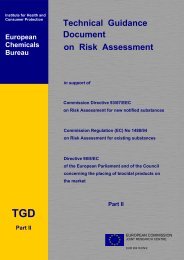Challenges of Regulation and Risk Assessment of Nanomaterials
Challenges of Regulation and Risk Assessment of Nanomaterials
Challenges of Regulation and Risk Assessment of Nanomaterials
Create successful ePaper yourself
Turn your PDF publications into a flip-book with our unique Google optimized e-Paper software.
Life Cycle <strong>Assessment</strong> <strong>of</strong> <strong>Nanomaterials</strong> in polymer Nanocomposites<br />
(Nanopolytox approach)<br />
Vázquez-Campos S. 1 , Escamilla M. 1 , Janer G. 1 , Aubouy L. 1<br />
1 LEITAT Technological Center, C/ de la Innovació 2, 08225 Terrassa, Barcelona, Spain<br />
The increase in the production <strong>and</strong> use <strong>of</strong> engineered nanoparticles (NP) makes exposure <strong>of</strong> the<br />
natural environment to these compounds more <strong>and</strong> more likely (1). The risks posed by NP are<br />
determined by their potential hazards (such as toxicity), as well as by the extent the material will<br />
come into contact with an organism (2, 3). One approach that can improve the underst<strong>and</strong>ing <strong>of</strong> the<br />
possible impacts <strong>of</strong> nanotechnology is Life Cycle <strong>Assessment</strong> (LCA). This comprehensive analysis tool<br />
can be used to evaluate how a product or material affects ecosystems <strong>and</strong> human health from its<br />
production to its end-<strong>of</strong>-life. It is now universally accepted that the product life cycle is the proper<br />
perspective for thinking about materials (4), including nanoparticles. Currently, knowledge <strong>of</strong> the<br />
exposure routes <strong>and</strong> <strong>of</strong> the potential environmental impacts <strong>of</strong> nanoparticles is limited. In addition,<br />
potential resource <strong>and</strong> environmental advantages <strong>of</strong> nanomaterials <strong>and</strong> products using<br />
nanomaterials over conventional products are, in most <strong>of</strong> the cases, under investigation. Therefore, a<br />
clear need exists to establish a full underst<strong>and</strong>ing <strong>of</strong> the environmental benefits <strong>and</strong> drawbacks <strong>of</strong><br />
nanotechnology <strong>and</strong> nanomaterials compared with those <strong>of</strong> conventional technologies <strong>and</strong> products<br />
over their complete life cycles. LCA is the essential tool to achieve this.<br />
Nanopolytox will use the LCA tool to evaluate the environmental impact <strong>of</strong> polymeric<br />
nanocomposites <strong>of</strong> different nanomaterials (Carbon nanotubes, nanoclays <strong>and</strong> metal oxide<br />
nanoparticles) over their life cycle. The application areas consider for the LCA study will be those<br />
where the products are fabricated for external uses (automotive, aeronautics, construction…). These<br />
nanocomposites will be studied in all their life cycle stages as: i) manufactured nanocomposites, ii)<br />
processed nanocomposites, iii) aged nanocomposites <strong>and</strong> iv) recycled nanocomposites. The general<br />
considerations proposed in Nanopolytox for the LCA methodology will be explained in this<br />
presentation.<br />
1 Nowack B et al, Environ. Pollut. 2007, 150, 5-12.<br />
2 Wiesner, MR et al, Environ. Sci. Technol. 2006, 40, 4336-4345.<br />
3 Colvin VL, Nat. Biotechnol. 2003, 21, 1166-1170.<br />
4 Davis JM, J. Nanosci. Nanotechnol. 2007, 7, 1-8.<br />
26








